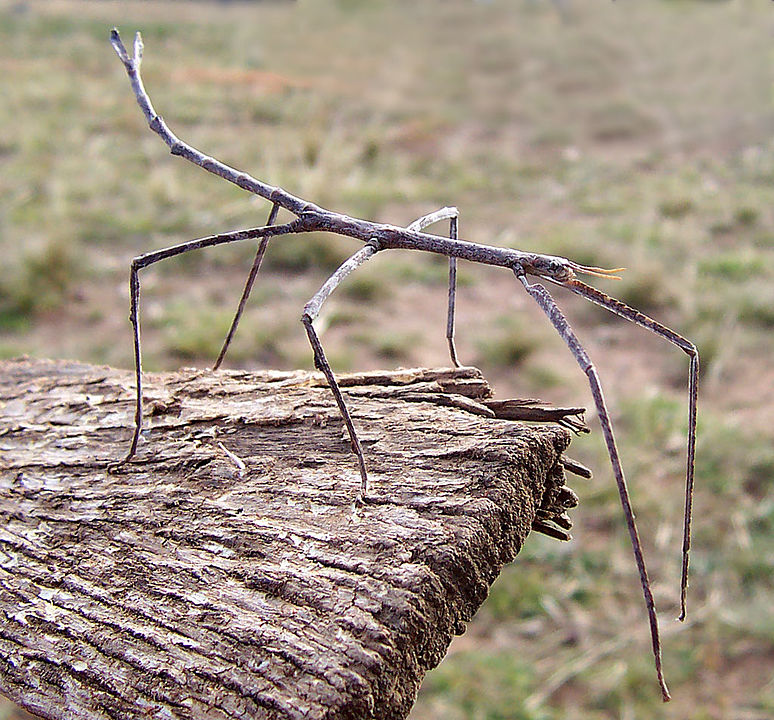
Why do stick insects look like plants? They have evolved to resemble the plants they live and feed on, in order not to be eaten by birds and other animals.
Stick insects are a wonderful example of natural selection at work. There are over 6,000 species of stick insect in the world, and they live on every continent except for Antarctica. All of the species are different in their color, size, shape, behavior, and ideal climate. It is difficult to know when they first appeared because they are very delicate and haven’t left many fossils. However, the general idea is that they were around by the end of the Carboniferous era and the start of the Permian era, so approximately 300 million years ago. By the Triassic era, about 225 million years ago. By the close of the dinosaur era, they also evolved wings and the wings let them fly to other places where they carried on evolving. This mass migration appears to have coincided with the evolution of small mammals and birds that preyed on the early stick insects. They evolved wings to escape and then continued evolving to stay hidden. Stick insects are actually unique because they have re-evolved wings on several occasions. Many animals lose their wings when they no longer need them, but they never get them back. Stick insects in some areas have lost their wings, then wings appeared again to allow them to travel to different places.
Each species of stick insect has evolved to perfectly blend in with the environment it lives in. Here are some of the amazing things they have evolved to do. The first thing is obviously the way they look. Many stick insects resemble the sticks of native plant species, hence their name. Some of them also look like leaves, even with the veiny leaf texture. Some species have outgrowths that look like moss or lichen to further camouflage themselves.
They are able to enter a state of perfect stillness, where all of their muscles go rigid. A lot of animals, ourselves included, look for motion. If there is no motion, it is very difficult for an animal to see them. However, sometimes the opposite is true. If the wind is blowing and the whole plant is moving, the stick insect that is rigid will stand out. To avoid this, many stick insect species have evolved a rocking motion, so they blend in with the moving leaves or sticks.
Stick insects have evolved a way of protecting and dispersing their eggs as well. Many stick insect eggs look like the seeds of plants. Scientists couldn’t work out why because they thought it would increase the likelihood of the eggs being eaten, but that is actually what the stick insects want. Plants disperse their seeds to avoid having competition for resources and stick insects do the same thing with their eggs. Some plant seeds are sticky or have small hooks so they will stick to the fur of passing animals, and some stick insect eggs are the same. Many plant seeds are inside fruit and are constructed so that they will pass intact through the digestive system of an animal. Many stick insect eggs are the same. Tests have shown that they will survive the passage through a bird’s digestion. Some plant seeds are covered in a fatty layer so that insects will carry them away. Some stick insect eggs also have a fatty layer. It attracts ants that carry the eggs into their nests. The ants eat the fatty bit and the egg hatches in the ant’s nest. The stick insect nymph has evolved to look like an ant, so it can travel through the ant’s nest unharmed, and then head up into the forest. Amazing.
How did they evolve these traits? It is a perfect example of natural selection. Birds feed on stick insects. If one stick insect, purely by chance, is born with a mutation that makes it slightly harder for the birds to see, it will probably survive while the other, less well-hidden stick insects are eaten. That means there is more of a chance that it will be able to reproduce and there is more of a chance that its offspring will have the same mutation. This process will continue. However, it is an ongoing process because some birds might evolve the ability to see even the most well-hidden stick insects, which means the stick insects need to evolve again. Evolution never stops. And this is what I learned today.
Image By I, the copyright holder of this work, hereby publish it under the following license: – Own work, CC BY-SA 3.0, https://commons.wikimedia.org/w/index.php?curid=197235
Sources
https://royalsocietypublishing.org/doi/10.1098/rsos.201689
https://en.wikipedia.org/wiki/Phasmatodea
